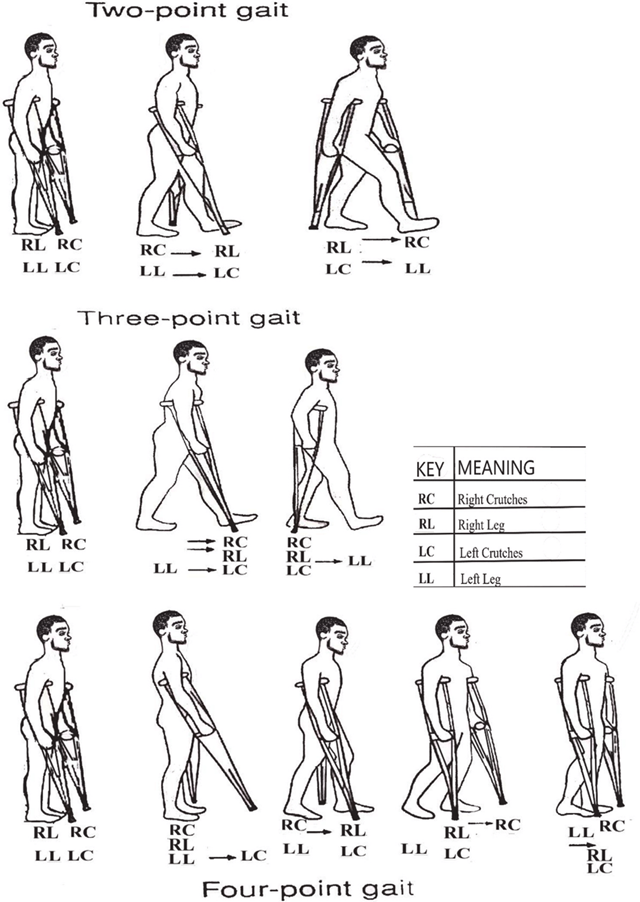The nurse is demonstrating three point gait crutch walking to an older adult client who broke a foot while playing soccer with the grandchildren. Which behavior Indicates that the client understands proper crutch walking?
Progresses to foot touchdown and weight bearing of affected leg.
Practices bicep and triceps isometric exercises.
Inspects crutches to ensure rubber tips are intact.
Bears body weight on the palms of hands during the crutch gait.
The Correct Answer is A
A. Progresses to foot touchdown and weight bearing of affected leg:
This choice indicates that the client understands proper crutch walking because it involves the correct progression of weight-bearing on the affected leg while using the crutches for support. In the three-point gait crutch walking technique, the client progresses by first touching down the foot of the affected leg and then transferring weight onto that leg while stepping forward with the crutches. This behavior ensures proper balance and support during ambulation.
B. Practices bicep and triceps isometric exercises:
This choice does not directly indicate understanding of proper crutch walking. While strengthening the biceps and triceps muscles can be beneficial for overall strength and endurance, it is not a specific behavior related to proper crutch walking technique.
C. Inspects crutches to ensure rubber tips are intact:
While it is important to inspect crutches regularly to ensure they are in good condition, this behavior alone does not necessarily indicate an understanding of proper crutch walking technique. It is more related to equipment maintenance and safety rather than the actual execution of crutch walking.
D. Bears body weight on the palms of hands during the crutch gait:
This choice suggests an incorrect technique. Proper crutch walking technique involves bearing weight on the hands through the hand grips of the crutches rather than the palms. Placing excessive weight on the palms can lead to discomfort, injury, and improper weight distribution, which could hinder effective ambulation.

Nursing Test Bank
Naxlex Comprehensive Predictor Exams
Related Questions
Correct Answer is A
Explanation
A. Progresses to foot touchdown and weight bearing of affected leg:
This choice indicates that the client understands proper crutch walking because it involves the correct progression of weight-bearing on the affected leg while using the crutches for support. In the three-point gait crutch walking technique, the client progresses by first touching down the foot of the affected leg and then transferring weight onto that leg while stepping forward with the crutches. This behavior ensures proper balance and support during ambulation.
B. Practices bicep and triceps isometric exercises:
This choice does not directly indicate understanding of proper crutch walking. While strengthening the biceps and triceps muscles can be beneficial for overall strength and endurance, it is not a specific behavior related to proper crutch walking technique.
C. Inspects crutches to ensure rubber tips are intact:
While it is important to inspect crutches regularly to ensure they are in good condition, this behavior alone does not necessarily indicate an understanding of proper crutch walking technique. It is more related to equipment maintenance and safety rather than the actual execution of crutch walking.
D. Bears body weight on the palms of hands during the crutch gait:
This choice suggests an incorrect technique. Proper crutch walking technique involves bearing weight on the hands through the hand grips of the crutches rather than the palms. Placing excessive weight on the palms can lead to discomfort, injury, and improper weight distribution, which could hinder effective ambulation.

Correct Answer is ["0.5"]
Explanation
To find out how many milliliters the nurse should administer, we first need to calculate the volume required to deliver 200 mg of streptomycin.
Given:
Streptomycin concentration: 1 gram/2.5 mL
Dose prescribed: 200 mg
We'll start by converting the dose prescribed from milligrams (mg) to grams (g) since the concentration is given in grams:
200 mg = 0.2 grams
Now, we can set up a proportion to find the volume (x) needed to deliver 0.2 grams of streptomycin:
1 gram / 2.5 mL = 0.2 grams / x
Cross-multiplying:
1 * x = 0.2 * 2.5
x = 0.5 mL
So, the nurse should administer 0.5 milliliters of streptomycin.
Whether you are a student looking to ace your exams or a practicing nurse seeking to enhance your expertise , our nursing education contents will empower you with the confidence and competence to make a difference in the lives of patients and become a respected leader in the healthcare field.
Visit Naxlex, invest in your future and unlock endless possibilities with our unparalleled nursing education contents today
Report Wrong Answer on the Current Question
Do you disagree with the answer? If yes, what is your expected answer? Explain.
Kindly be descriptive with the issue you are facing.
